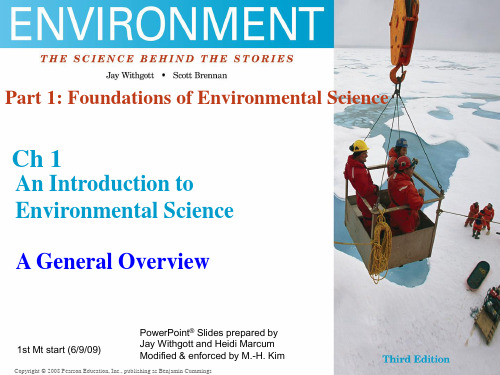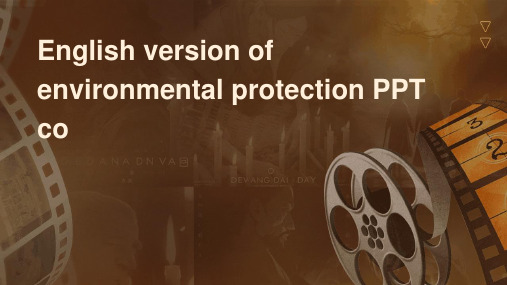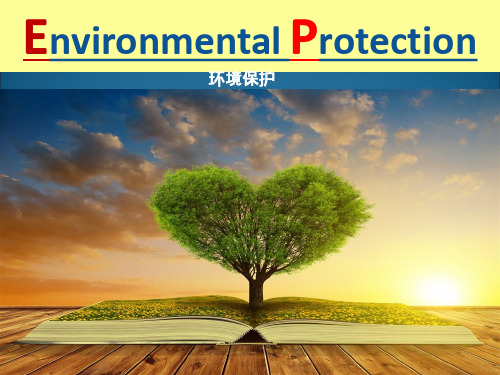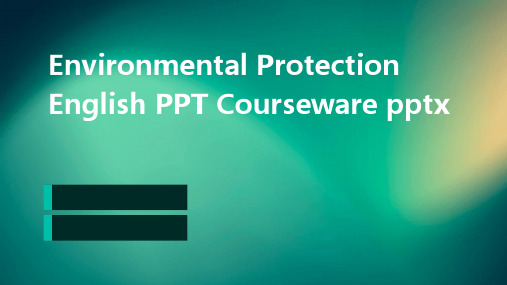环境科学概论教学课件(第二讲)英文版PPT
《环境科学概论》PPT课件(2024)

生态系统破坏
生物多样性的丧失导致生态系统功能下降,影响 人类福祉。
生物入侵
外来物种的入侵对原生生态系统造成破坏,威胁 本地物种的生存。
2024/1/30
27
固体废弃物处理问题透视
垃圾围城
城市化进程中,固体废 弃物产生量迅速增长, 处理能力不足导致垃圾 围城现象。
2024/1/30
土壤和水体污染
固体废弃物的不当处理 会对土壤和水体造成严 重污染。
8
水圈层结构与功能
水圈层结构
包括海洋、河流、湖泊、冰川、地下 水等。
人类活动对水圈层的影响
过度开采地下水导致水位下降、排放 污染物导致水体污染等。
水圈层功能
调节地球气候、提供水资源、维持生 态系统平衡等。
2024/1/30
9
岩石圈层结构与功能
2024/1/30
岩石圈层结构
包括地壳、地幔和地核等。
4
环境科学的研究对象与任务
研究对象
主要研究人类活动对自然环境的 影响以及自然环境对人类社会的
反作用。
2024/1/30
研究任务
揭示环境问题的本质和规律,提出 解决环境问题的科学依据和技术途 径,促进环境保护与可持续发展。
研究内容
包括环境地学、环境生物学、环境 化学、环境物理学、环境工程学等 多个分支领域。
2024/1/30
加强环境教育和意识培养
通过环境教育提高公众环保意识,培养环保 行为习惯。
29
THANKS
感谢观看
2024/1/30
30
2024/1/30
14
土壤污染现状及危害分析
土壤污染现状
农业生产中大量使用化肥和农药,以及工业废弃物和城市垃圾的不当处理,导致 土壤受到严重污染。
环境科学概论 英文

Environment: the total of our surroundings
• All the things around us with which we interact: Biotic vs. Abiotic
• Living things
• Animals, plants, forests, fungi, etc. • Nonliving things • Continents, oceans, clouds, soil, rocks • Our built environment
Copyright © 2008 Pearson Education, Inc., publishing as Benjamin Cummings
3.14(12,800km) = 40,200km 3.14(8,000mi) = 25,000mi 25,000mi/(70mi/hr) = 360hrs = 15days 25,000mi/(600mi/hr) = 42hrs ~ 2days
Copyright © 2006 Pearson Education, Inc., publishing as Benjamin Cummings Copyright © 2008 Pearson Education, Inc., publishing as Benjamin Cummings
®® PowerPoint Slides prepared by PowerPoint Slides prepared by Jay Withgott and Heidi Marcum Jay Withgott and Heidi Marcum Modified & enforced by M.-H. Kim
环境保护英文ppt-17页精选文档

If we
ourselves themselves
谢谢!
• last year, my dormitory went to Suzhou classic garden. It is an antique garden with beautiful flowers and various trees. It is the representative of Chinese garden. And it is decorated by manmade rivers, different kinds of rockeries, the unique bridges and so forth. Once you enter the garden, you will find you just like a pure man in the ancient. You may even believe you are not living in the modern city but the peaceful area without armored concrete, chaos, benefits and so on.
It is China’s largest Theme park of the fourth generation, consisting of 15 main parts. And my favorite part is the “World of Universe”----the perfect application of high technology.
《英文版环保》课件

Environmental protection is crucial for maintaining the health and well being of humans and other living organizations A clean and safe environment is necessary for basic human needs such as clean water, air, and land
The main sources of radio active contamination are nuclear power plants, nuclear weapons testing, and the proposal of radio active waste
Radioactive coordination has caused serious damage to human health and has become a global environmental issue
Avoiding buying products made from endangered animals or plants
Support companies that use sustainable practices in their operations
Participate in local wildlife protection programs or events
Environmental protection has been an ongoing concern for many disciplines The first Earth Day was cellular in 1970, sparking a wave of environmental activism and promoting governments to pass environmental laws and regulations to address pollution and resource exploration
环境保护PPT(英文版)

poisonous wastes---毒性废弃物越境转移
NO.1
Global warming
◆Gradually increasing the greenhouse effect, Earth's
temperature rising. ◆ Main hazards(危害): abnormal weather, species extinction, the sea level rising.
NO.2
Ozone layer depletion
◆ Ozone (O3) layer: the Earth's protective layer ◆ Main hazards:
strong UV (ultra-violet ray紫外线) radiation can damage immune system(免疫系统) of human natures and animals , cause skin cancer and cataracts(白内障), damage to the earth’s ecosystems(全球生态系统).
NO.6 Desertification
◆ 600 million square kilometers of land into desert பைடு நூலகம்ach
year.
NO.7
Air pollution
2环境科学概论第二章PPT课件

元素或难分解的化合物,以致随着生长发育,浓缩系数不断 增大的现象
生物放大:biomagnification,指生态系统中,某中元素或
难分解化合物在生物机体中的浓度随营养级的提高而逐步增 大的现象
第四节 水体污染与自净
二 水体自净 受污染水体经过水中物理、化学与生物作 用,使污染物浓度降低,并逐步恢复到污 染前的水平 什么时间开始?
一 水体污染
2. 水体污染机制
物理作用:改变物理性状、空间位置 化学、物理化学作用:成分间及发生化学性质、价态变化,
但未参与生物作用
生物作用:生物的生理生化作用及及食物链的传递作
用、转化作用和富集作用
生物作用
生物富集作用:bioconcengtration,又称生物浓缩,生物或
处于同一营养级的生物种群,从周围环境中蓄积某种元素或 难分解化合物,使生物体内该物质的浓度超过环境中浓度的 现象
第二节 水体与水体污染
二 水质 1. 天然水
悬浮物质:细菌、藻类、原生动物、泥沙、粘土 胶体物质:溶胶、高分子化合物、其他不溶性物质 盐类:Ca、Mg、Na、Fe、Mn
气体:O2、CO2、H2S、N2、其他
第三节 水质污染指标
水体富营养化
存在天然和人为两种类型 共性:水体中N、P营养物质富集,(容易)
一 、水环境污染防治对策 二 、废水处理方法
一 水环境污染防治对策
1. 控制污染物排放量及减少污染源排放工业废水
量 1)控制水环境质量标准
水质标准 工业废水排放标准
2)减少耗水量
1)控制水环境质量标准
水质标准:为了保障人体健康、维护生态平衡、保护水资
环境科学概论教学课件(第一讲)英文版PPT

Main topics of this chapter
• The Nature of Environmental Science • An Ecosystem Approach • Political and Economic Issues • The global nature of Environmental Concerns • Regional Environmental Concerns • The Wilderness North • The Agricultural Middle • The Dry West • The Froested West • The Great lakes and Industrial Northeast • The Diverse South
14
CHAPTER ONE Environmental Interrelationships
OBJECTIVES After reading this chapter, you should be able to: Understand why environmental problems are complex and interrelated. Realize that environmental problems involve social, political, and economic issues, not just scientific issues. Understand that acceptable solutions to environmental problems are not often easy to achieve. Understand that all organisms have an impact on their surroundings. Understand what is meant by an ecosystem approach to environmental problem solving. Recognize that different geographic regions have somewhat different environmental problems, but the process for resolving them is the same and involves compromise.
英文版环境保护演示文稿PPT课件

Water pollution is the contamination of water bodies such as lakes, rivers, oceans, lagoons, and groundwater. All water pollution affects organisms and plants that live in these bodies of water and in almost all cases the effect is damaging either to individual species and populations but also to the natural biological communities. It occurs when pollutants are discharged directly or indirectly into water bodies without adequate treatment to remove harmful constituents.
go on cutting down trees.
6
What does our earth look like?
And what should we do?
7
Energy conservation
▪ Use green shopping bags instead of plastics
▪ Turn off the light before you get out
5
A large number of forests have been lopment. As we all know, trees are able to
环境保护PPT(英文版)

纪发展。但在追求的同时,有一个新 的问题出现,那就是环境。不得不承 认,地球目前的现状越来越恶劣。到 处都是白色污染,到处都是水资源 匮乏,到处都是二氧化碳排放。人们 在发展的同时,是否应该回过头来 看看,那些已经无法挽救的,生命。
The world's
top ten environmental problems
世界十大环境问题
◆ 1.Global warming---全球变暖 ◆ 2.Ozone layer depletion---臭氧层破坏 ◆ 3.Loss of biodiversity---生物多样性减少 ◆ 4.The spread of acid rain---酸雨蔓延 ◆ 5.Forest dropped---森林锐减
Environmental Protection
环境保护
Environment
is the things around the center of things
环境是一切的中心
Now, more and more for the society developing high-tech brokerage. But at the same time, in pursuit of a new problem appeared that environment. Acknowledge the current situation, the earth is becoming worse and worse. Everywhere is white pollution, everywhere is scarcity, everywhere is carbon dioxide emissions. People in the development at the same time, whether should return overdo see, those who had saved the life
2024年度《环境科学概论》PPT课件

水能、风能、太阳能等可再生能源的开发利用过程中也会 对环境造成一定影响,如水电站建设对河流生态系统的影 响、风电场对鸟类迁徙的影响等。
能源利用效率问题
能源利用效率不高会导致资源浪费和环境污染加剧,提高 能源利用效率是减少环境问题的重要途径之一。
17
PART 04
环境污染防治技术与方法 介绍
城市环境污染
城市生活污水、垃圾等废弃物对周围环境造成污染,影响居民生 活和健康。
城市热岛效应
城市化进程中大量建筑物和道路等人工构筑物导致城市热岛效应 加剧,影响城市气候和居民生活。
2024/2/2
16
能源开发利用过程中环境问题认识
2024/2/2
化石能源开采利用
煤炭、石油等化石能源的开采和利用过程中会产生大量废 气、废水和固废等污染物,对环境和人类健康造成影响。
《环境科学概论》 PPT课件
REPORTING
2024/2/2
1
目录
• 环境科学基本概念与原理 • 自然环境系统组成要素及相互作用 • 人类社会活动对自然环境影响评价 • 环境污染防治技术与方法介绍 • 生态环境保护与修复策略探讨 • 全球变化背景下环境科学发展趋势预测
2024/2/2
2
PART 01
生物多样性保护方法
建立自然保护区、实施物种保护 计划、推广生态农业和可持续利 用资源等。
生物多样性监测与评估
通过对生物多样性进行定期监测 和评估,了解其动态变化,为保 护措施的制定和调整提供依据。
2024/2/2
25
退化生态系统恢复重建技术
退化生态系统成因分析
分析生态系统退化的原因,如过度开发、环境污染、气候变化等。
保护环境的PPT英文版PPT课件

05
The Future and Our Role
Objectives of the Presentation
01
To introduce the audience to the concept of environmental protection.
02
To highlight the importance of environmental protection and its impact on society and the economy.
03
To provide information on sustainable development and practical ways to protect the environment.
02
The Environment and Human
Interference
The Ecosystem
Details
Methods for reducing waste include using sustainable packaging materials, such as paper or cardboard; using recyclable items, such as glass or aluminum; and composting organic waste.
Details
Protecting Habitats
最新保护环境的PPT英文版讲课稿

thank you
此课件下载可自行编辑修改,仅供参考! 感谢您的支持,我们努力做得更好! 谢谢!
保护环境的PPT英文版
大气污染 Air pollution
工业污染 INDUSTRIAL POLLUTION
水污染 Water pollutant
空气污染 air pollution
What can we do?
我们的环保守则
• Saving paper. Recycling and useaper, recycled paper.
when you wash and brush • Discharge sewage after treatment
• Plant more trees; protect the forests and all the animals
• Use of renewable materials • Restrict the use of private cars • Implement of sustainable economic
• 环保从自己.每时每刻做起,用行动去感染别人
Energy conservation
• Use green shopping bags instead of plastics
• Turn off the light before you get out
• Raise the temperature of air-conditioning
• As far as possible need not plastic bags, use environmental protection bags
• Environmental protection from yourself. Every moment, with actions to infect others
保护环境的PPT英文版

Loss of soil fertility and productivity
Changes in soil chemistry and biology
Groundwater pollution and soil erosion
Global Warming
Causes of Global Warming Emission of greenhouse gases: CO2, methane, nitrogen oxide
The industrial revolution has broken about rapid economic
growth, but also caused environmental pollution and
resource waste
The large amount of emissions from factories and power plants has serially pooled the air, water,
Importance of environmental protection
Environmental protection is crucial for safeguarding human health and well being
It attributes to the conservation of natural resources and biodiversity, ensuring sustainable use of ecosystems
01
CHAPTER
Introduction
Background of the issue
The global community has recognized the urgent need to address environmental challenges to ensure sustainable development
Environmental Protection English PPT Courseware pp

•Overview of Environmental Protection•Environmental pollution and hazards•Natural resource protection and 目sustainable utilization•Ecological protection and biodiversity 录•Environmental pollution controltechnology and methods•Environmental protection policies and 目regulations录01Overview ofEnvironmentalProtectionDefinition and ImportanceProtectionEarly BeginningsIncident civilizations have some environmental protection practices, suchas forest conservation and water managementProtectionIndustrial RevolutionRapid industrialization led to significant environmental degradationEmergence of early conservation movements in the 19th century输入标题02010403Protectionenvironmental protectionChallengesClimate change, causing extreme weather events and rising sea levels Biodiversity loss due to habitat destruction and overexploitation of resourcesenvironmental protectionenvironmental protectionOpportunitiesTransition to renewable energy sources to reduce greenhouse gasemissionsAdoption of circular economic practices to minimize waste andpromote resource efficiencyenvironmental protection010202Environmentalpollution and hazardsAir pollutionSources of air pollution01Health effects of air pollution02Measures to reduce air pollution03Water pollutionSources of water pollutionEffects of water pollutionMeasures to reduce water pollutionSoil pollutionSources of soil pollutionindustrial waste, pests and fertilizers, urban waste, etcEffects of soil pollutionsoil degradation, loss of fertility, contamination of food chain, etcMeasures to reduce soil pollutionproper waste disposal, reduce pest and fertilizer use, adapt sustainableagricultural practices, etcSources of noise pollution Effects of noisepollutionMeasures toreduce noisepollution010203 Noise pollution03Natural resourceprotection andsustainable utilizationImportance of Forests01Deforestation and its sequences 02Forest protection measures031 2 3Importance of water Water pollution and scaling Water protection measuresImportance of minerals Unsustainable mining practices Sustainable mining practicesImportance of energyFossil fuel dependence and its impacts Sustainable energy solutions04Ecological protectionand biodiversityComponents of ecosystems Tropical levels andfood chainsEcosystemservicesThe structure and function of ecosystemsThe significance and value of biodiversityBiodiversity definitionImportance of biodiversityThreats to biodiversityIn siteconservationprotecting and managing ecosystems and natural habitats to preserve biodiversity within its natural range要点一要点二Ex situconservationpreserving biodiversity outside its natural habitat in places such as botanical gardens, zoos, and seed banksEducation and awareness raisingincreasing public understanding and application of biodiversity and its value through education and reach programs要点三Measures and methods for biodiversity conservationEcological restorationThe process of assisting the recovery of an ecosystem that has been degraded, damaged, or destroyedmethods such as planning,soil improvement, andreintroduction ofspecifications to restoreecological function andbiodiversityexamples of successfulecological restorationprojects around the world,highlighting best practicesand lessons learned ReconstructiontechniquesCase studiesEcological restoration and reconstruction05Environmentalpollution controltechnology andmethodsAir pollution control technologyEmission reduction technologyAir purification technologyAtmospheric environment monitoring technologyWater pollution control technology Waste treatment technologyWater resource conservation technologyAquatic environment monitoring technologySolid Waste Disposal TechnologyWaste sorting and recycling technologySeparate waste at the source, recycle resources, and reduce the amount ofwaste that needs to be disposed ofWaste incineration and landfill technologyDispose of waste through incineration or landfill, while taking measures toreduce pollution emissions and protect the environmentHazardous waste treatment technologyTreat hazardous waste through special methods to ensure safe disposal andprevent environmental pollution01 02 03Noise source control technology Noise transmission control technology Noise receiver protection technologyNoise control technology06Environmentalprotection policiesand regulationsUnited Nations Environment Program (UNEP): UNEP promotes international cooperation on environmental issues and provides guidance to Paris Agreement: Adoptedin 2015, the ParisAgreement aims to limitglobal warming to wellbelow 2 degrees Celsiusand push efforts to limit itBasel Convention: The BaselConvention regulates thetransitional movements ofhazardous waste and theirdisposal, promoting thereduction, reuse, recycling,International environmental protection policies and regulationsChina's environmental protection policies and regulationsEnvironmental Protection LawAir Pollution Prevention and Control LawWATCHING。
- 1、下载文档前请自行甄别文档内容的完整性,平台不提供额外的编辑、内容补充、找答案等附加服务。
- 2、"仅部分预览"的文档,不可在线预览部分如存在完整性等问题,可反馈申请退款(可完整预览的文档不适用该条件!)。
- 3、如文档侵犯您的权益,请联系客服反馈,我们会尽快为您处理(人工客服工作时间:9:00-18:30)。
Niche: is the functional role it has in its surroundings (its profession).
13
2 The Role of Natural Selection and Evolution Population: a group of individuals of the same species inhabiting a particular area at a specific time.
7
1 Ecological Concepts
Ecology: is the study of the ways organisms interact with each other and with their nonliving surroundings.
Environment: Everything that affects an organism during its lifetime is collectively known as its environment. it is useful to subdivide the concept of environment into abiotic (nonliving) and biotic (living) factors. Abiotic factors can be organized into several broad categories: energy, nonliving matter, and processes that involve the interaction of nonliving matter and energy. Biotic factors include all forms of life with which it interacts.
CHAPTER TWO Interactions: Environment and
Organisms
1
Bee and sunflower
2
Soybean and rhizobium
3
Fish and coral
Fish and shrimp
4
eagle frog
paddy
grasshopper
Species : is a population of organisms in which the individuals are potentially able to interbreed and produce fertile offspring.
10
Environment is the home.
Habitat(生境):The habitat of an organism is the space that th place where it lives (its address) .
11
12
5
snake
6
OBJECTIVES After reading this chapter, you should be able to: Identify the abiotic and biotic factors in an ecosystem. . Define niche. Describe the process of natural selection as it operates to refine the fit between organism, habitat, and niche. Describe predator-prey, parasite-host, competitive, mutualistic, and commensalistic relationships. Differentiate between a community and an ecosystem. List some of the components of an ecosystem. Define the roles of producer, herbivore, carnivore, omnivore, and decomposer. . Describe energy flow in an ecosystem. Relate the concepts of food webs and food chains to trophic levels. Explain the cycling of nutrients such as nitrogen, carbon, and phosphorus through an ecosystem.
Limiting Factors: A shortage or absence of a key factor restricts the success of the species; thus the factor is known as a limiting factor.
Habitat: The habitat of an organism is the space that the organism inhabits, the place where it lives (its address) Niche: is the functional role it has in its surroundings (its profession).
8
Composition of an ecosystem
Biotic environment
Abiotic environment
9
Limiting factor: A shortage or absence of a
key factor restricts the success of the species; thus the factor is known as a limiting factor.
